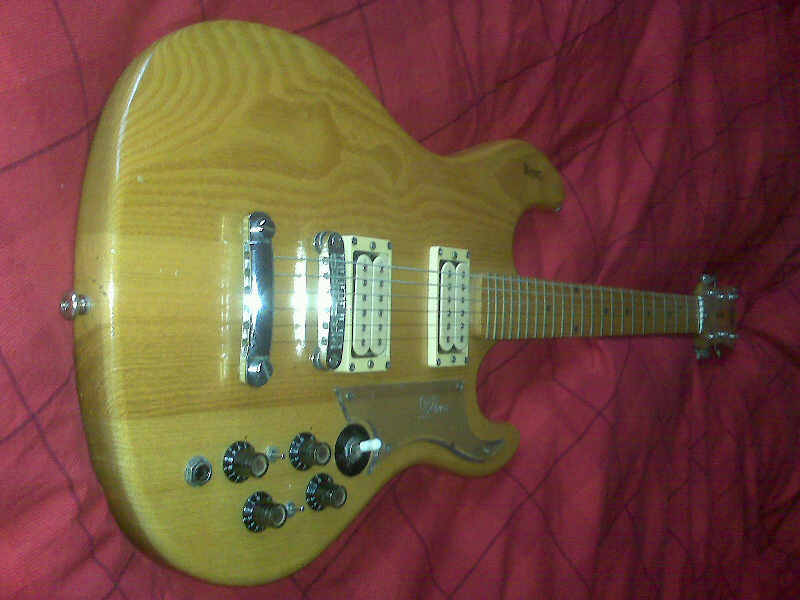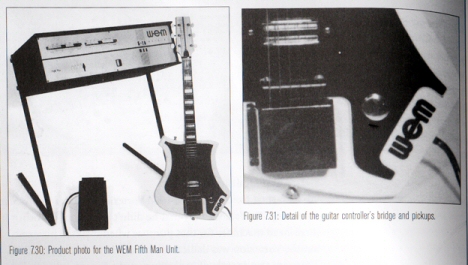The late Geoff Gaskell sent me some photos of an original mahogany finish Super 6 which he used to own. He said it was one of the loudest and heaviest guitars he had ever owned
|
|
THE MERCURY 6
This was a mid 70s model produced by Wilson as they diversified away from the classic Rapier shapes. Not many were produced. These photos of #16851 were supplied by Nick Harling and the guitar was owned by Geoff Gaskell.
|
|
|
.jpg) |
LATER BODY SHAPE MERCURY
.jpg)
Here's an unusual model owned by Chris Hobbs which I have never come across before. It is a later version of the Mercury and shares a lot of design similarities with the Super Six and W-Type. Serial # 19196 would seem to date it at the end of the 1970s, possibly early 80's as the factory was running down production. It is unlikely to have sold in large numbers
THE HAND-MADE MERCURY
.jpg)
.jpg)
This rare Mercury was basically a hand-built special of the Super Six and saw a return to the Rapier shape although with a much thicker and heavier body. It was marketed as being individually made by Sid Watkins. This guitar above is owned by Richard Bettis. There have been a few mods to the pickup selectors.

.jpg)
The above two pictures are of Kevin Leahy's hand-made Mercury made to special order and which he has owned from new. Kevin's father, James Leahy, was a paint sprayer at the Caxton House Watkins guitar factory
.jpg)
Above - a pair of specially commissioned Wilson Mercury guitars from 1976 which are still in the same ownership today.
Many thanks to Paul for the picture.
|
THE W-TYPE
This is another early 70s Wilson model produced in very few numbers and doesn't often appear on the second hand market
|
.jpg) .jpg)
Below - a rare 12 String W-Type from Jack Priestley
.jpg)
.jpg)
|
|
THE PROJECT IV (4) FIFTH MAN |
.JPG)
Every successful and innovative company like Watkins/WEM are entitled to put out the occasional turkey and here it is! Finer than frog's hair and rarer than hen's teeth, the Project 4. This is a weird combination of a guitar and an effects unit having fuzz and phase sounds built in. It is best described by Charlie Watkins:
"This guitar evolved from the WEM guitar Organ (the Fifth Man)which played an organ generator from the fretboard. It was the biggest commercial disaster I ever invented. It was too big, too expensive and took too long for me to realise that a guy buys a guitar because that's the sound he wants in his ear. If he wanted organ sound he would probably buy an organ!
The Project 4 fuzz sound comes from the bridge itself and not from the pickups. The drive comes from the funny magnet arrangement by the bridge designed for me by a professor at Sussex University in 1965 which was about the year we started to sell them"
.JPG)
Part of the scary electronics under the scratchplate of my Project IV # 51507
The Project IV guitar is certainly full of mysteries.
Charlie Watkins has said that the key to the guitar's operation was a magnetic arrangement in the bridge. Having examined my guitar carefully, all I can see which is special about the bridge is that each string is electrically insulated from the rest and a wire is taken from each string under the scratchplate where some circuitry is applied (see photo below). It looks extremely complex under the scratchplate but this is because a three transistor effect circuit is reproduced six times on the circuit board (once for each string). There are preset pots on the circuit board which appear to be used to adjust the tone of the sound and amplitude for each string.
.jpg)
A further mystery has arisen. Tim Hall has sent me a picture of his guitar which shows two magnets attached either side of the neck at the junction with the body. No other Project IV I have seen has these magnets and their purpose is still to be investigated.
.jpg)
Thanks to Tim Hall for the above photo of his Project IV # 12726
The technically brilliant but commercially disasterous Fifth Man guitar organ is shown below.
It was produced for the 1965 Frankfurt Music Exhibition but was too expensive and cumbersome. The electonics were condensed into the Project IV above hence the "Fifth Man" logo on the Project IV scratchplate.
|

THE ESPANA RANGE (Rebranded WEM for Export to US)
.jpg)
|
.jpg)
Above and below are catalogue pictures of the Espana range of guitars which I believe were produced by the Watkins factory betweeen 1964 1nd 1968 purely for export to the US. The three crown logo was later used as a headstock motif on Wilson guitars . See comments on the WEM Emerald above.
.jpg)
Espana headstock and three crown logo
.jpg)
EL32 12-string from Gus Roberts in Australia
two pickups non-original
%20(Small).JPG)
Espana EL-20 belonging to Andy Swan. Pics supplied by John Higney
|
|
|

